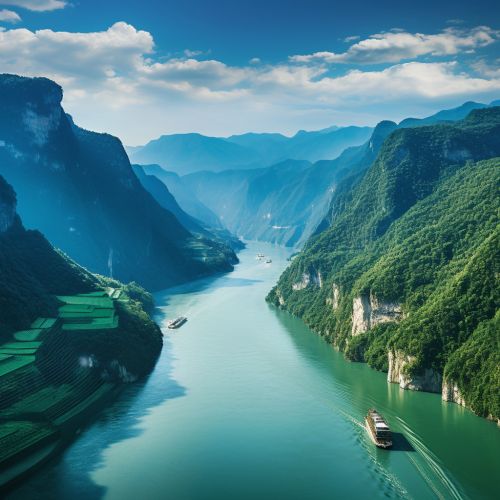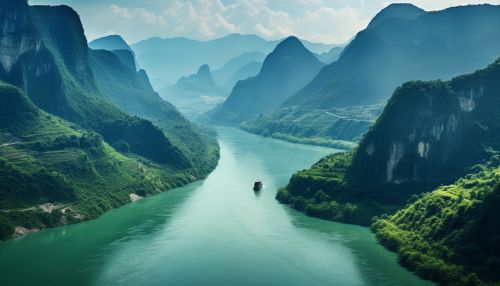Three Gorges
Overview
The Three Gorges is a scenic area along the Yangtze River in the People's Republic of China, which is noted for its natural beauty. The "Three Gorges" refers to the Qutang, Wu, and Xiling gorges, all of which are located along this section of the river. The area is also home to the Three Gorges Dam, one of the world's largest hydroelectric power stations.


Geography
The Three Gorges span the provinces of Sichuan and Hubei in central China. They cover a total length of approximately 200 kilometers. The Qutang Gorge is the shortest and most dramatic. The Wu Gorge is known for its quiet beauty, forest-covered mountains, and cliffs so sheer that the sun barely penetrates the precipices. The Xiling Gorge is the longest, and is historically noted for being the most dangerous of the three gorges to travel through, with numerous rapids and other navigational hazards.
Geology
The gorges are located in the Yangtze River's upper reaches, where the river cuts through the Wushan Mountains. The gorges' formation is due to millions of years of erosion, coupled with the region's complex geological history, which includes several seismic events. The gorges are known for their steep and towering cliffs, which are a result of this ongoing erosion process.
Ecology
The Three Gorges region is home to a diverse range of plant and animal species. Some of these, like the Chinese paddlefish and the Yangtze River dolphin, are endemic to the Yangtze River system. The region's flora is characterized by a mix of subtropical and temperate deciduous forests, with species like the Chinese tulip tree and the dawn redwood being particularly common.
History
The Three Gorges has long been one of China's most famous tourist destinations. Its history as a tourist attraction dates back to the Tang Dynasty, when it was celebrated in poetry and song. The gorges have also played a significant role in Chinese history, serving as a natural barrier against invasions and a transportation route during various periods.
Three Gorges Dam
The Three Gorges Dam is a hydroelectric dam that spans the Yangtze River in the Three Gorges region. It is the world's largest power station in terms of installed capacity. The dam's construction significantly altered the region's landscape and ecology, and displaced a large number of local residents.
Impact on local communities
The construction of the Three Gorges Dam has had significant impacts on local communities. Over a million people were relocated from towns and villages in the area. The dam's reservoir has also submerged a number of cultural and archaeological sites, leading to loss of cultural heritage.
Tourism
Despite the environmental and social impacts of the dam's construction, the Three Gorges region remains a popular tourist destination. The area's natural beauty, combined with the engineering marvel of the dam, attracts millions of visitors each year.
